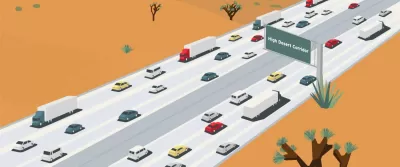What could have been the first new freeway for Los Angeles County in decades might now only mark the end of an era.

"A recent court settlement spells the end for the planned High Desert Corridor Freeway," reports Joe Linton from Southern California.
The High Desert Corridor would have been an $8 billion, 63-mile freeway spanning two counties—Los Angeles and San Bernardino. "In 2016, Caltrans certified the project’s Environmental Impact Report (EIR). The plan was for a High Desert 'multi-purpose corridor' featuring an 8-10 lane freeway, plus bike path, solar panels, and high-speed rail," according to Linton. The project was also lined up for nearly $2 billion in funding from Measure M, the L.A. County transportation sales tax approved by voters in 2016.
As explained by Linton, the project's EIR provoked a lawsuit from environmental groups, challenging the project on terms set by both state and federal environmental regulations. A judge sided with the plaintiffs, finding that the EIR was insufficient in measuring biological and greenhouse gas impacts. Instead of drafting a supplemental EIR, Caltrans has decided to shelve the project, reports Linton.
Frontier Group and U.S. PIRG earlier this year named the project as one of the nation's worst highway boondoggles, and now that the project is dead, the Los Angeles Times Editorial Board has taken a firm stance in opposition to the idea. The editorial raises one salient question that continues to plague land use and transportation planners in the state of California: Why is a state committed to reducing emissions and continuing to allow so much development in far-flung, exurban communities? The Trump administration has even begun to exploit the state's hypocrisy.
FULL STORY: Caltrans Settles Environment Lawsuit, Cancels High Desert Freeway Project

Alabama: Trump Terminates Settlements for Black Communities Harmed By Raw Sewage
Trump deemed the landmark civil rights agreement “illegal DEI and environmental justice policy.”

Planetizen Federal Action Tracker
A weekly monitor of how Trump’s orders and actions are impacting planners and planning in America.

Why Should We Subsidize Public Transportation?
Many public transit agencies face financial stress due to rising costs, declining fare revenue, and declining subsidies. Transit advocates must provide a strong business case for increasing public transit funding.

Understanding Road Diets
An explainer from Momentum highlights the advantages of reducing vehicle lanes in favor of more bike, transit, and pedestrian infrastructure.

New California Law Regulates Warehouse Pollution
A new law tightens building and emissions regulations for large distribution warehouses to mitigate air pollution and traffic in surrounding communities.

Phoenix Announces Opening Date for Light Rail Extension
The South Central extension will connect South Phoenix to downtown and other major hubs starting on June 7.
Urban Design for Planners 1: Software Tools
This six-course series explores essential urban design concepts using open source software and equips planners with the tools they need to participate fully in the urban design process.
Planning for Universal Design
Learn the tools for implementing Universal Design in planning regulations.
Caltrans
Smith Gee Studio
Institute for Housing and Urban Development Studies (IHS)
City of Grandview
Harvard GSD Executive Education
Toledo-Lucas County Plan Commissions
Salt Lake City
NYU Wagner Graduate School of Public Service





























